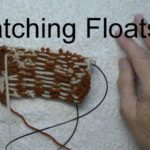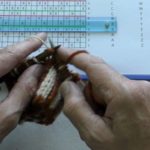T-torials: Online tutorials from Teabreak Knitter
We all need help learning new techniques – or finding out why the technique we have used for years isn’t working on this project. You will find some suggestions on this page. ![]()

Reading charts for colour knitting (T201908)
Updated May 2020 Charts are often used to provide instructions on how to create intarsia or stranded colour work motifs. This T-torial explains how to interpret and use these charts ...

Vertical stripe rib (T201905)
Vertical stripe rib is a form of stranded knitting. It is often used for the edging of stranded knitting projects, such as cuffs and neck bands. Like standard rib it does not curl, but it does not stretch either ...

Cutting a steek (T202004)
A steek is an area of knitted fabric that is designed to be cut. This allows, for example, a sweater to continue to be knit in the round (circular knitting) after the start of the armholes. The last step in making fabric with a steek is to cut the central ...

Reinforcing a steek with crochet (T202001)
Steeks are used when knitting in the round to allow arm holes, cardigan openings and other cuts to be made in the fabric. This T-torial explains how to use the crochet technique to reinforce steeks, so that the loose ends at the cut do not pull loose ...

Pick-up stitches at a steek (T202003)
This T-torial shows how to pick-up and knit stitches along the edge stitches of a steek. It shows how to do this using two needles, a crochet hook and a needle, and with a single needle. This method helps the steek stitches to lie flat against the body of the ...

Knitting backwards (T202002)
Knitting backwards (or mirror knitting) is a technique that allows you to keep the public (right) side of your work facing you while you knit. This T-torial shows how to make knit and purl stitches while taking stitches from the right hand needle to make the new ones on the ...

Using symmetry to avoid mistakes (T201911)
The underlined headings below are links that take you to that section in the YouTube video for this tutorial. Introduction Hello. I'm Steve, also known as Teabreak Knitter on social media. In this T-torial I want to tell you how I use the ideas of symmetry to help me spot ...

Casting on for steeks (T201909)
Steeks allow you to knit in the round even when the finished item may not be continuous (for example a cardigan, or any garment with armholes). This t-torial suggests one way of casting-on the extra stitches for a steek that takes account of how the steek will be reinforced ...

Decreases in colour work (T201910)
How you work your decreases makes a difference to the appearance of your colour work ...

Catching floats in stranded knitting (T201907)
You may want to avoid long floats when there are several stitches of the same colour together in a stranded knitting project . This t-torial explains one way of doing this by catching (or trapping) the floats ...

Holding yarn for stranded knitting (T201906)
Updated August 2020. This T-torial suggests several ways of holding the yarn when using two colours for stranded knitting ...

Marker thread for cast-on and joining in the round (T201904)
Show notes for the marker thread for cast-on and joining in the round tutorial ...

Twisted knit half-hitch cast-on (T201903)
Show notes for the twisted knit half-hitch cast-on tutorial ...

Basic stranded cast-off (T201902)
Show notes for the basic stranded cast-off tutorial ...

Basic stranded cast-on (T201901)
Show notes for the Basic Stranded Cast-on Tutorial ...

Making a t-card (T201801)
Making a t-card is as simple or as difficult as you want. This t-torial guides you through the process ...


